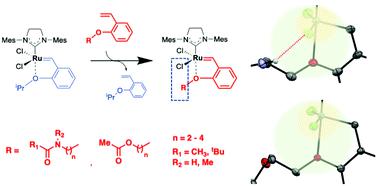当前位置:
X-MOL 学术
›
Dalton Trans.
›
论文详情
Our official English website, www.x-mol.net, welcomes your
feedback! (Note: you will need to create a separate account there.)
Second-coordination sphere effects on the reactivities of Hoveyda-Grubbs-type catalysts: a ligand exchange study using phenolic moiety-functionalized ligands.
Dalton Transactions ( IF 3.5 ) Pub Date : 2020-07-25 , DOI: 10.1039/d0dt02353a Catur Jatmika 1 , Kenta Goshima 1 , Kazumo Wakabayashi 1 , Naoki Akiyama 1 , Shun Hirota 1 , Takashi Matsuo 1
Dalton Transactions ( IF 3.5 ) Pub Date : 2020-07-25 , DOI: 10.1039/d0dt02353a Catur Jatmika 1 , Kenta Goshima 1 , Kazumo Wakabayashi 1 , Naoki Akiyama 1 , Shun Hirota 1 , Takashi Matsuo 1
Affiliation

|
The Hoveyda–Grubbs (HG) second-generation catalyst (HG-II), a Ru complex with a 2-isopropoxybenzylidene ligand, is extensively used for olefin metathesis, the rearrangement of carbon–carbon double bonds. A well-known strategy to control its complex reactivity is to modify the phenyl ring in the ligand, thereby directly influencing the coordination of the phenolic oxygen to the metal center. We, herein, report that a functional group attached to the phenolic moiety in the 2-alkoxybenzylidene ligand can indirectly affect the reactivities of HG-type complexes. In this work, the ligand exchange reactions between HG-II and phenolic moiety-modified 2-alkoxybenzylidene ligands are useful for evaluating the structural effects of the ligands. Specifically, an ethylene amide or an ester group at the terminal phenolic moiety in the benzylidene ligand was found to influence the relative stabilities of HG-type complexes compared to that of the HG-II complex. The structural analyses proved that the observed effects of the functional groups on the complex stabilities originate from the interactions with a chlorido ligand in HG-type complexes without changes in coordination fashions at the metal centers. It was found that the outer-sphere interactions also influence the catalytic activities of HG-type complexes, namely, the properties of HG-type complexes can be controlled by outer-sphere structural factors toward the metal center (i.e., “the second-coordination sphere effect”). In the design of functionalized HG-type complexes, the outer-sphere structural effects need to be considered in addition to the optimization of the metal coordination site.
中文翻译:

第二配位球对Hoveyda-Grubbs型催化剂的反应活性的影响:使用酚部分官能化的配体进行配体交换研究。
Hoveyda-Grubbs(HG)第二代催化剂(HG-II)是带有2-异丙氧基亚苄基配体的Ru络合物,被广泛用于烯烃复分解,即碳-碳双键的重排。控制其复杂反应性的众所周知的策略是修饰配体中的苯环,从而直接影响酚氧与金属中心的配位。我们在本文中报道,连接至2-烷氧基亚苄基配体中的酚部分的官能团可间接影响HG型复合物的反应性。在这项工作中,HG-II与酚部分改性的2-烷氧基亚苄基配体之间的配体交换反应可用于评估配体的结构效果。特别,发现亚苄基配体中末端酚部分的亚乙基酰胺或酯基与HG-II配合物相比影响HG-型配合物的相对稳定性。结构分析证明,观察到的官能团对络合物稳定性的影响源自与HG型络合物中氯代配体的相互作用,而在金属中心的配位方式没有变化。发现外球相互作用也影响HG型配合物的催化活性,即HG型配合物的性质可以由朝向金属中心的外球结构因素控制(结构分析证明,观察到的官能团对络合物稳定性的影响源自与HG型络合物中氯代配体的相互作用,而在金属中心的配位方式没有变化。发现外球相互作用也影响HG型配合物的催化活性,即HG型配合物的性质可以由朝向金属中心的外球结构因素控制(结构分析证明,所观察到的官能团对络合物稳定性的影响源于与HG型络合物中氯代配体的相互作用,而在金属中心的配位方式没有变化。发现外球相互作用也影响HG型配合物的催化活性,即HG型配合物的性质可以由朝向金属中心的外球结构因素控制(即“第二配位范围效应”)。在功能化HG型配合物的设计中,除了优化金属配位位点外,还需要考虑外层结构的影响。
更新日期:2020-08-25
中文翻译:

第二配位球对Hoveyda-Grubbs型催化剂的反应活性的影响:使用酚部分官能化的配体进行配体交换研究。
Hoveyda-Grubbs(HG)第二代催化剂(HG-II)是带有2-异丙氧基亚苄基配体的Ru络合物,被广泛用于烯烃复分解,即碳-碳双键的重排。控制其复杂反应性的众所周知的策略是修饰配体中的苯环,从而直接影响酚氧与金属中心的配位。我们在本文中报道,连接至2-烷氧基亚苄基配体中的酚部分的官能团可间接影响HG型复合物的反应性。在这项工作中,HG-II与酚部分改性的2-烷氧基亚苄基配体之间的配体交换反应可用于评估配体的结构效果。特别,发现亚苄基配体中末端酚部分的亚乙基酰胺或酯基与HG-II配合物相比影响HG-型配合物的相对稳定性。结构分析证明,观察到的官能团对络合物稳定性的影响源自与HG型络合物中氯代配体的相互作用,而在金属中心的配位方式没有变化。发现外球相互作用也影响HG型配合物的催化活性,即HG型配合物的性质可以由朝向金属中心的外球结构因素控制(结构分析证明,观察到的官能团对络合物稳定性的影响源自与HG型络合物中氯代配体的相互作用,而在金属中心的配位方式没有变化。发现外球相互作用也影响HG型配合物的催化活性,即HG型配合物的性质可以由朝向金属中心的外球结构因素控制(结构分析证明,所观察到的官能团对络合物稳定性的影响源于与HG型络合物中氯代配体的相互作用,而在金属中心的配位方式没有变化。发现外球相互作用也影响HG型配合物的催化活性,即HG型配合物的性质可以由朝向金属中心的外球结构因素控制(即“第二配位范围效应”)。在功能化HG型配合物的设计中,除了优化金属配位位点外,还需要考虑外层结构的影响。






























 京公网安备 11010802027423号
京公网安备 11010802027423号